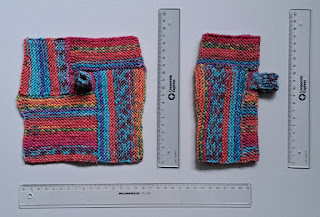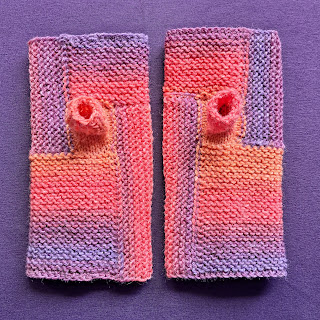I love knitted pieces with constructions that are a bit out of the ordinary. These fingerless gloves have a middle part knitted on a 45 degree angle. They are all in garter stitch and mainly knitted knitted flat (back and forth) – with the exception of the thumb.
They are a great way to show off variegated or self-striping yarn. Because the lengths of the rows vary, colour pooling is less probable.
- written row-by-row instructions for knitting these gloves in one size – including twelve photos of the different stages (the finished piece (unstretched garter stitch) measures 17 cm in height, with a circumference of 15 cm at the top and 17 cm at the bottom)
- explanations how to adapt the pattern to other sizes
- explanations how to knit a variation of these pieces with stockinette stitch in the middle
- short photo tutorials for the following techniques
- Magic CO
- kbf (a stitch symmetrical to a kfb)
- Three-Needle Bind Off
- German Short Rows and how to work the resulting “double-stitch”
- Picking up Stitches from a gap to avoid holes
- About 150 meters of fingering weight yarn -
- for the ones in the title picture I used Hedgehog Fibres, Skinny Singles, (colorway Goblin)
- for the ones with the contrast stripes, I used Lana Grosse Meilenweit Socktober (colorway 18314321, green), with Wollmeise Pure (dark blue) for the contrasting stripes
- for the ones with a stockinette part (see below) I used Supergarne Aktiv 4-fach (colorway 3358)
- 3mm circular knitting needles – at least 80 cm long
- 3 stitch markers – one of them removable






















